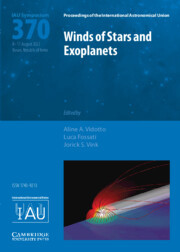Winds of Stars and Exoplanets (IAU S370) Proceedings of the International Astronomical Union Symposia and Colloquia Series
Langue : Anglais
Coordonnateurs : Vidotto Aline, Fossati Luca, Vink Jorick

Winds form an integral part of astronomy ? from regulating rotation of stars through enriching galaxies with fresh materials. Outflowing winds persist during the entire lives of stars and play a key role in shaping the exoplanet demographics we observe. In massive stars, their winds are a vital ingredient of their evolution, from the main sequence to the pre-supernova stage, determining black hole masses as measured from gravitational waves. In the case of low-mass stars, their winds dictate rotational evolution, which affect angular momentum distribution within the stellar interior and thus the generation of magnetic fields. In the case of planets, winds take the form of atmospheric escape, which can strongly affect their atmospheric evolution. IAU Symposium 370 brings together researchers on winds of exoplanets and stars, including the solar wind, to share insights into the physics and modelling tools used by these different communities.
Part I. Overview of winds of stars and exoplanets: 1. Winds and magnetospheres from stars and planets: similarities and differences; 2. Observations of winds and CMEs of low-mass stars; 3. Observations of outflows of massive stars; Part II. Observational evidence of winds: 4. Observations of planetary winds and outflows; 5. The effect of winds in red supergiants: modeling for interferometry; 6. The porous envelope and circumstellar wind matter of the closest carbon star, CW Leonis; 7. Is the magnetospheric accretion active in the Herbig Ae/Be stars?; 8. Short-term variations of surface magnetism and prominences of the young sun-like star V530 Per; 9. Water and silicon-monoxide masers monitored towards the 'water fountain' sources; 10. Weakening the wind with ULLYSES: Examining the Bi-stability jump; 11. Statistical properties of cold circumstellar envelops observed in NESS-NRO; 12. The origin of planetary winds; 13. Stellar wind from low-mass main-sequence stars: an overview of theoretical models; 14. The driving of hot star winds; 15. Slingshot prominences, formation, ejection and cycle frequency in cool stars; Part III. Physical ingredients of winds: 16. Effect of stellar flares and coronal mass ejections on the atmospheric escape from hot Jupiters; 17. Physics of the atmospheric escape driven by EUV photoionization heating: Classification of the hydrodynamic escape in close-in planets; 18. Discrete absorption components from 3-D spot models of hot star winds; 19. Hydrodynamic disk solutions for Be stars using HDUST; 20. Role of longitudinal waves in Alfvén-wave-driven solar/stellar wind; 21. ISOSCELES Grid of stellar atmosphere and hydrodynamic models of massive stars: The first results; 22. Quantification of the environment of cool stars using numerical simulations; 23. Hydrodynamic solutions of radiation driven wind from hot stars; 24. Gap opening by planets in discs with magnetised winds; 25. Solar wind and hydrologic cycle; 26. Magnetic confinement in the wind of low mass stars; 27. Clumping and X-rays in cool B supergiants; 28. Interaction between massive star winds and the interstellar medium; 29. Numerical modeling of galactic superwinds with time-evolving stellar feedback; Part IV. Flow-flow interactions: 30. Winds of OB stars: impact of metallicity, rotation and binary interaction; 31. X-ray view of colliding winds in WR 25; 32. Double tail structure in escaping atmospheres of magnetised close-in giant planets; 33. Shock breakout in winds of red supergiants: Type IIP supernovae; 34. On the making of a PN: the interaction of a multiple stellar wind with the ISM; 35. Role of planetary winds in planet evolution and population; 36. Size evolution and orbital architecture of KEPLER small planets through giant impacts and photoevaporation; Part V. Relevance of winds on stellar/planetary evolution: 37. Spin-down and reduced mass loss in early-type stars with large-scale magnetic fields; 38. Mass loss implementation and temperature evolution of very massive stars; 39. The evolution of atmospheric escape of highly irradiated gassy exoplanets; 40. The future of Jupiter-like planets around Sun-like stars: first steps; 41. Rapid orbital precession of the eclipsing binary HS Hydrae; 42. To the dynamics of the two-body problem with variable masses in the presence of reactive forces; 43; Evolution equations of the multi-planetary problem with variable masses; 44. Planet migration in accretion discs in binary systems; 45. Signatures of wind formation in optical spectra of precursors of planetary nebulae.
Date de parution : 09-2023
Ouvrage de 300 p.
17.9x25.3 cm
Disponible chez l'éditeur (délai d'approvisionnement : 14 jours).
Prix indicatif 125,23 €
Ajouter au panierThème de Winds of Stars and Exoplanets (IAU S370) :
© 2024 LAVOISIER S.A.S.



